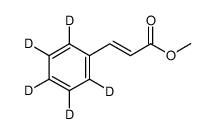Methyl (E)-cinnamate-d5
Modify Date: 2025-08-27 20:14:12

Methyl (E)-cinnamate-d5 structure
|
Common Name | Methyl (E)-cinnamate-d5 | ||
|---|---|---|---|---|
| CAS Number | 61764-82-7 | Molecular Weight | 167.21600 | |
| Density | N/A | Boiling Point | N/A | |
| Molecular Formula | C10H5D5O2 | Melting Point | N/A | |
| MSDS | N/A | Flash Point | N/A | |
Use of Methyl (E)-cinnamate-d5Methyl (E)-cinnamate-d5 is the deuterium labeled Methyl (E)-cinnamate[1]. Methyl (E)-cinnamate (EMC), a phytochemical constituent isolated from Alpinia katsumadai Hayata, is a natural flavor compound with anti-inflammatory properties. Methyl (E)-cinnamate is widely used in the food and commodity industry[2]. |
| Name | methyl trans-cinnamate-d5 (phenyl-d5) |
|---|
| Description | Methyl (E)-cinnamate-d5 is the deuterium labeled Methyl (E)-cinnamate[1]. Methyl (E)-cinnamate (EMC), a phytochemical constituent isolated from Alpinia katsumadai Hayata, is a natural flavor compound with anti-inflammatory properties. Methyl (E)-cinnamate is widely used in the food and commodity industry[2]. |
|---|---|
| Related Catalog | |
| In Vitro | Stable heavy isotopes of hydrogen, carbon, and other elements have been incorporated into drug molecules, largely as tracers for quantitation during the drug development process. Deuteration has gained attention because of its potential to affect the pharmacokinetic and metabolic profiles of drugs[1]. |
| References |
| Molecular Formula | C10H5D5O2 |
|---|---|
| Molecular Weight | 167.21600 |
| Exact Mass | 167.09900 |
| PSA | 26.30000 |
| LogP | 1.87280 |
| InChIKey | CCRCUPLGCSFEDV-XLKVIOBLSA-N |
| SMILES | COC(=O)C=Cc1ccccc1 |